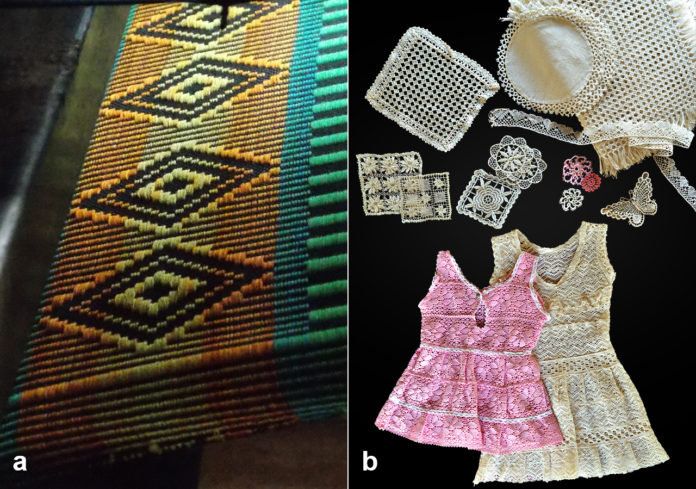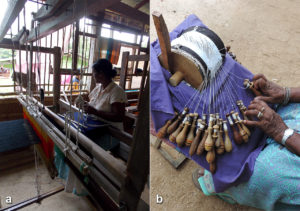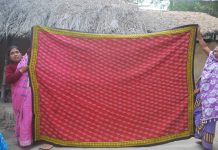
Spinning and weaving is the oldest craft in Sri Lanka. According to legend, it is dated to sixth century BC. It reached the level of a sophisticated craft during the Kandyan period (1469-1815 AD) when hereditary craftsmen in the Dumbara valley near the capital city of Kandy produced hand-woven cloths with traditional designs based on leaves, flowers, animals or geometric patterns for the royal court and the public. Descendants of some of those families still practice the craft.

Photo and image credits: Amila Indika, Asitha Amarakoon, and B.D. Nandadeva
Women in different parts of the island practice embroidery, patchwork, and quilt work as textile-based crafts. Making of lace, known as bīralu or rēnda, introduced during the Portuguese and the Dutch rule (1505-1796 AD), is practiced by women in villages around Galle, Weligama, Matara, and Hambantota along the southern coastal area. Batik, introduced from Indonesia in the seventeenth century is a popular craft of fabric decoration.
Techniques of weaving are similar to that of other parts of the region. Weft threads wind under and over the warp threads that run parallel to each other. Wooden heddles separate the warp threads as weft threads are carried by a shuttle from side to side. Lace makers use the “pillow technique” or the “needlepoint technique”. Batik craftsmen use wax or tie-and-dye methods.
Cotton or silk-cotton (from Kapok tree) were used to make yarns. Textile techniques, from harvesting of cotton to spinning of yarns, were women’s jobs, but men joined in weaving. Traditionally, unbleached yarns were dyed in red, blue, and black using mineral or vegetable colourants. Today, craftspersons use imported synthetic dyes of brilliant colours. Noticeable regional variations are absent, perhaps due to the small size of the country.
Today, with support from the Department of Small Industries, National Handloom Centre, and few entrepreneurs like Barbara Sansoni of Barefoot Gallery, craftspersons at centers across the country produce a variety of textiles including cotton and silk furnishings, household linen, wall-hangings, and fine cloth suitable for contemporary taste and foreign market. Lace making that has been fully “naturalized” as a cottage industry. Producing strips of lace, table cloths, table mats, and women’s dresses etc. is very popular among young unemployed women as the craft brings good financial returns. All textile related crafts sustain lucrative businesses due to demand by the local affluent class and foreign buyers.




